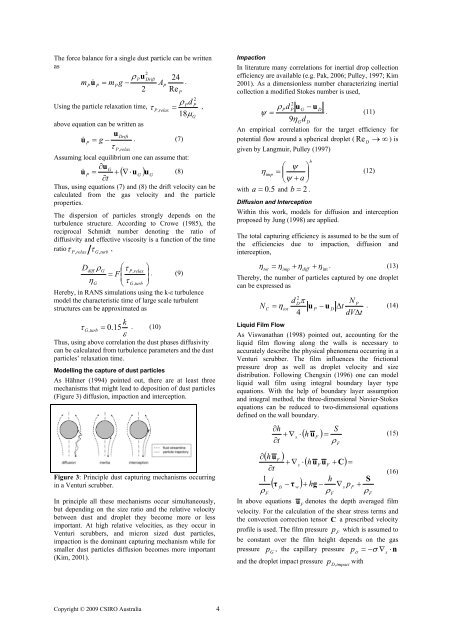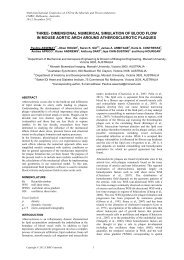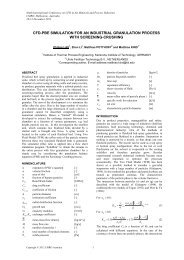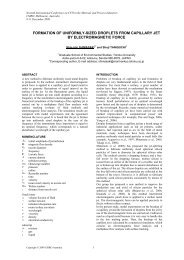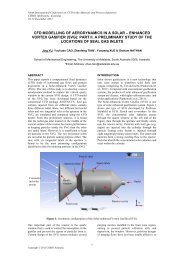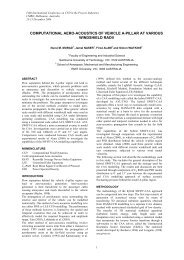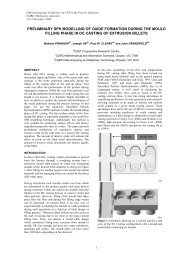simulation of offgas scrubbing by a combined eulerian ... - CFD
simulation of offgas scrubbing by a combined eulerian ... - CFD
simulation of offgas scrubbing by a combined eulerian ... - CFD
You also want an ePaper? Increase the reach of your titles
YUMPU automatically turns print PDFs into web optimized ePapers that Google loves.
The force balance for a single dust particle can be written<br />
as<br />
2<br />
ρ Pu<br />
Drift 24<br />
mPu&<br />
P = mP<br />
g − A .<br />
P<br />
2 Re<br />
Using the particle relaxation time,<br />
Copyright © 2009 CSIRO Australia 4<br />
τ<br />
P<br />
ρ d<br />
2<br />
P P<br />
P,<br />
relax = ,<br />
18μG<br />
above equation can be written as<br />
u& u Drift<br />
= g − . (7)<br />
P<br />
τ<br />
P,<br />
relax<br />
Assuming local equilibrium one can assume that:<br />
∂uG<br />
u& P = + ( ∇ ⋅u<br />
G ) u (8)<br />
G<br />
∂t<br />
Thus, using equations (7) and (8) the drift velocity can be<br />
calculated from the gas velocity and the particle<br />
properties.<br />
The dispersion <strong>of</strong> particles strongly depends on the<br />
turbulence structure. According to Crowe (1985), the<br />
reciprocal Schmidt number denoting the ratio <strong>of</strong><br />
diffusivity and effective viscosity is a function <strong>of</strong> the time<br />
τ τ ,<br />
ratio P , relax G,<br />
turb<br />
Ddiff<br />
ρG<br />
⎛τ<br />
⎞ P,<br />
relax<br />
= F⎜<br />
⎟ . (9)<br />
η ⎜ ⎟<br />
G ⎝ τ G,<br />
turb ⎠<br />
Here<strong>by</strong>, in RANS <strong>simulation</strong>s using the k-ε turbulence<br />
model the characteristic time <strong>of</strong> large scale turbulent<br />
structures can be approximated as<br />
τ<br />
k<br />
0.<br />
15<br />
ε<br />
G,<br />
turb = . (10)<br />
Thus, using above correlation the dust phases diffusivity<br />
can be calculated from turbulence parameters and the dust<br />
particles’ relaxation time.<br />
Modelling the capture <strong>of</strong> dust particles<br />
As Hähner (1994) pointed out, there are at least three<br />
mechanisms that might lead to deposition <strong>of</strong> dust particles<br />
(Figure 3) diffusion, impaction and interception.<br />
Figure 3: Principle dust capturing mechanisms occurring<br />
in a Venturi scrubber.<br />
In principle all these mechanisms occur simultaneously,<br />
but depending on the size ratio and the relative velocity<br />
between dust and droplet they become more or less<br />
important. At high relative velocities, as they occur in<br />
Venturi scrubbers, and micron sized dust particles,<br />
impaction is the dominant capturing mechanism while for<br />
smaller dust particles diffusion becomes more important<br />
(Kim, 2001).<br />
Impaction<br />
In literature many correlations for inertial drop collection<br />
efficiency are available (e.g. Pak, 2006; Pulley, 1997; Kim<br />
2001). As a dimensionless number characterizing inertial<br />
collection a modified Stokes number is used,<br />
ψ<br />
ρ d<br />
u − u<br />
=<br />
P<br />
2<br />
P G<br />
9η<br />
Gd<br />
D<br />
D<br />
. (11)<br />
An empirical correlation for the target efficiency for<br />
potential flow around a spherical droplet ( Re D → ∞ ) is<br />
given <strong>by</strong> Langmuir, Pulley (1997)<br />
imp<br />
a ⎟ ⎛ ψ ⎞<br />
η = ⎜<br />
⎝ψ<br />
+ ⎠<br />
with a = 0.<br />
5 and b = 2 .<br />
(12)<br />
Diffusion and Interception<br />
b<br />
Within this work, models for diffusion and interception<br />
proposed <strong>by</strong> Jung (1998) are applied.<br />
The total capturing efficiency is assumed to be the sum <strong>of</strong><br />
the efficiencies due to impaction, diffusion and<br />
interception,<br />
η +<br />
= η + η η . (13)<br />
tot imp diff int<br />
There<strong>by</strong>, the number <strong>of</strong> particles captured <strong>by</strong> one droplet<br />
can be expressed as<br />
N<br />
C<br />
Liquid Film Flow<br />
2<br />
d Dπ<br />
N P<br />
= η tot u P − u D Δt<br />
. (14)<br />
4<br />
dVΔt<br />
As Viswanathan (1998) pointed out, accounting for the<br />
liquid film flowing along the walls is necessary to<br />
accurately describe the physical phenomena occurring in a<br />
Venturi scrubber. The film influences the frictional<br />
pressure drop as well as droplet velocity and size<br />
distribution. Following Chengxin (1996) one can model<br />
liquid wall film using integral boundary layer type<br />
equations. With the help <strong>of</strong> boundary layer assumption<br />
and integral method, the three-dimensional Navier-Stokes<br />
equations can be reduced to two-dimensional equations<br />
defined on the wall boundary.<br />
∂h<br />
+ ∇<br />
∂t<br />
( hu<br />
)<br />
∂<br />
∂t<br />
1<br />
ρ<br />
F<br />
F<br />
s<br />
⋅<br />
( τ − τ )<br />
fs<br />
+ ∇<br />
w<br />
s<br />
S<br />
u F =<br />
(15)<br />
ρ<br />
( h )<br />
⋅<br />
F<br />
( hu<br />
u + C)<br />
F<br />
F<br />
h<br />
+ hg<br />
− ∇<br />
ρ<br />
F<br />
s<br />
=<br />
p<br />
F<br />
S<br />
+<br />
ρ<br />
F<br />
(16)<br />
In above equations u denotes the depth averaged film<br />
F<br />
velocity. For the calculation <strong>of</strong> the shear stress terms and<br />
the convection correction tensor C a prescribed velocity<br />
pr<strong>of</strong>ile is used. The film pressure p which is assumed to<br />
F<br />
be constant over the film height depends on the gas<br />
p , the capillary pressure n ⋅ ∇ − p σ<br />
pressure G<br />
and the droplet impact pressure p with<br />
D,<br />
impact<br />
= σ<br />
s


